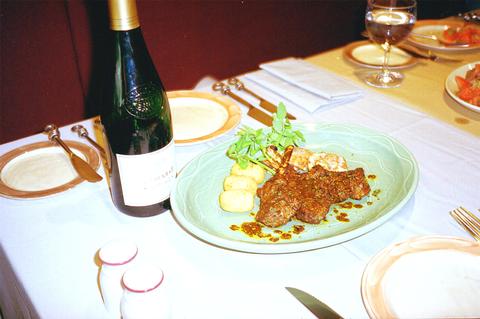The Latin ambiance is pretty popular these days, especially in music, but in cuisine, the food of South America is not well represented in Taipei. Salsa Bistro, tucked away in a lane off fashionable Anho Road, might be leading a new dining sensation with its small but unusual menu and probably the best selection of Chilean wines you are likely to find in this city.
Salsa Bistro's managing director and executive chef Ali Lai (賴奕岭) has created a menu that is representative of much South American cuisine with the exception of Brazil, which has its own separate culinary traditions. The food is served very stylishly, and is prepared and presented in a manner "a little more sophisticated than what is usual in South America." The careful control of cooking time to make sure that lamb chops are nice and tender is an example of this management, but overall, Lai says that the dishes are true to the originals.

PHOTO: IAN BARTHOLOMEW, TAIPEI TIMES
Although small, Salsa Bistro produces everything on the premises, and even the simplest dishes such as the sopaipilla (pumpkin bread with a cilantro and chili sauce) are outstanding in flavor and visual appeal. Other dishes such as the seviche (sword fish marinated in lemon juice) and the empanaditas make great entrees and also a great accompaniment to the extensive wine list. A light refreshing Tarapaca sauvignon blanc is a great way to get the meal going, and for the main meal, moving on the Tarapaca Maipo Valley gran reserva is a recipe for bliss.
Lai, a Chinese born in Chili, came back to Taipei to start an import business for Chilean wine, which explains the extensive wine list (only Chilean wines), which are very well priced and represents a wide range of what Chilean vineyards are now capable of. Most wines are between NT$1,000 to NT$1,500, and dollar for dollar, you are doing much better than with most French wines. Main courses are attractively laid out, but servings are substantial and you won't be walking away hungry.
One of the house specialties is the baked corn and meat pastry (NT$300), which you are unlikely to find anywhere else, but even seemingly common dishes such as roast chicken (NT$500) and grilled lamb chops (NT$580) have a unique twist to them, full of the flavor of unexpected spices.
Salsa's decor does not seek to overplay the Latin theme, with pleasant music of the Buena Vista Social Club variety and traditional pottery, but otherwise aims at modern elegance. Service is knowledgeable, friendly and efficient, and Lai or her staff are on hand to provide explanations as to the various dishes and wines. To finish off the meal, Salsa also has excellent coffee.
Address: 9, Lane 141, Anho Road, Sec. 1, Taipei (台北市安和路一段141巷9號)
Telephone: 02-27003060
Open: Noon to 2:30pm (lunch); 6pm to 11pm (dinner)
Average meal: NT$500
Details: English menu available. Credit cards accepted

This month the government ordered a one-year block of Xiaohongshu (小紅書) or Rednote, a Chinese social media platform with more than 3 million users in Taiwan. The government pointed to widespread fraud activity on the platform, along with cybersecurity failures. Officials said that they had reached out to the company and asked it to change. However, they received no response. The pro-China parties, the Chinese Nationalist Party (KMT) and Taiwan People’s Party (TPP), immediately swung into action, denouncing the ban as an attack on free speech. This “free speech” claim was then echoed by the People’s Republic of China (PRC),

Exceptions to the rule are sometimes revealing. For a brief few years, there was an emerging ideological split between the Democratic Progressive Party (DPP) and Chinese Nationalist Party (KMT) that appeared to be pushing the DPP in a direction that would be considered more liberal, and the KMT more conservative. In the previous column, “The KMT-DPP’s bureaucrat-led developmental state” (Dec. 11, page 12), we examined how Taiwan’s democratic system developed, and how both the two main parties largely accepted a similar consensus on how Taiwan should be run domestically and did not split along the left-right lines more familiar in

Most heroes are remembered for the battles they fought. Taiwan’s Black Bat Squadron is remembered for flying into Chinese airspace 838 times between 1953 and 1967, and for the 148 men whose sacrifice bought the intelligence that kept Taiwan secure. Two-thirds of the squadron died carrying out missions most people wouldn’t learn about for another 40 years. The squadron lost 15 aircraft and 148 crew members over those 14 years, making it the deadliest unit in Taiwan’s military history by casualty rate. They flew at night, often at low altitudes, straight into some of the most heavily defended airspace in Asia.

Many people in Taiwan first learned about universal basic income (UBI) — the idea that the government should provide regular, no-strings-attached payments to each citizen — in 2019. While seeking the Democratic nomination for the 2020 US presidential election, Andrew Yang, a politician of Taiwanese descent, said that, if elected, he’d institute a UBI of US$1,000 per month to “get the economic boot off of people’s throats, allowing them to lift their heads up, breathe, and get excited for the future.” His campaign petered out, but the concept of UBI hasn’t gone away. Throughout the industrialized world, there are fears that